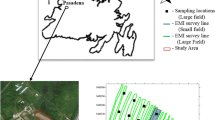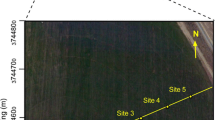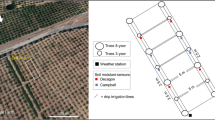Abstract
The general objectives of this study were to evaluate (i) the specificity of the spatial and temporal dynamics of apparent soil electrical conductivity (ECa) measured by a electromagnetic induction (EMI) sensor, over 7 years, in variable conditions (of soil moisture content (SMC), soil vegetation cover and grazing management) and, consequently, (ii) the potential for implementing site-specific management (SSM). The DUALEM 1S sensor was used to measure the ECa in a 6 ha pasture experimental field four times between June 2007 and February of 2013. Soil spatial variability was characterized by 76 samples, geo-referenced with the global positioning system (GPS). The soil was characterized in terms of texture, moisture content, pH, organic matter content, nitrogen, phosphorus and potassium. This study shows a significant temporal stability of the ECa patterns under several conditions, behavior that is an excellent indicator of reliability of this tool to survey spatial soil variability and to delineate potential site-specific management zones (SSMZ). Significant correlations were obtained in this work between the ECa and relative field elevation, pH, silt and soil moisture content. These results open perspectives for using the EMI sensor as an indicator of SMC in irrigation management and of needs of limestone correction in Mediterranean pastures. However, it is interesting to extend the findings to other types of soil to verify the origin of the lack of correlation between the ECa data measured by DUALEM sensor and properties such as the clay, organic matter or phosphorus soil content, fundamental parameters for establishment of pasture SSM projects.







Similar content being viewed by others
Abbreviations
- DHGN:
-
Dry soil, high and green vegetation, not grazed
- DSDG:
-
Dry soil, small and dry vegetation, grazed by sheep
- EMI:
-
Electromagnetic induction
- HMZ:
-
Homogeneous management zones
- PD:
-
Pseudo-dephts
- RECa :
-
Relative apparent soil electrical conductivity
- SMC:
-
Soil moisture content
- SSM:
-
Site-specific management
- SSMZ:
-
Site-specific management zones
- WSGG:
-
Wet soil, small and green vegetation, grazed by cattle
- WSGN:
-
Wet soil, small and green vegetation, not grazed
References
Blackmore, S. (2000). The importance of trends from multiple yield maps. Computers and Electronics in Agriculture, 26, 37–51.
Blackmore, S., Godwin, R., & Fountas, S. (2003). The analysis of spatial and temporal trends in yield map data over 6 years. Biosystems Engineering, 84, 455–466.
Brevik, E., Fenton, T., & Lazari, A. (2006). Soil electrical conductivity as a function of soil water content and implications for soil mapping. Precision Agriculture, 7, 393–404.
Bronson, K. F., Booker, J. D., Officer, S. J., Lascano, R. J., Maas, S. J., Searcy, S. W., et al. (2005). Apparent electrical conductivity, soil properties and spatial covariance in the U.S. Southern high plains. Precision Agriculture, 6, 297–311.
Corwin, D. L., & Lesch, S. M. (2003). Application of soil electrical conductivity to precision agriculture: Theory, principles, and guidelines. Agronomy Journal, 95, 455–471.
Corwin, D. L., & Lesch, S. M. (2005). Characterizing soil spatial variability with apparent soil electrical conductivity I. Survey protocols. Computers and Electronics in Agriculture, 46, 103–133.
ESRI. (2009). ArcView 9.3 GIS Geostatistical Analyst. Redlands: ESRI.
FAO. (2006). World reference base for soil resources. World Soil Resources Report No. 103. Rome: Food and Agriculture Organization of the United Nations.
Friedman, S. P. (2005). Soil properties influencing apparent electrical conductivity: A review. Computers and Electronics in Agriculture, 46, 45–70.
Huang, J., Nhan, T., Wong, V. N. L., Johnston, S. G., Lark, R. M., & Triantafilis, J. (2014). Digital soil mapping of a coastal acid sulfate soil landscape. Soil Research, 52, 327–339.
Huang, J., Scudiero, E., Choo, H., Corwin, D. L., & Triantafilis, J. (2016). Mapping soil moisture across an irrigated field using electromagnetic conductivity imaging. Agricultural Water Management, 163, 285–294.
Islam, M., Meerschman, E., Cockx, L., De Smedt, P., Meeuws, F., & Van Meirvenne, M. (2011). Comparison of apparent electrical conductivity measurements on a paddy field under flooded and drained conditions. In J. V. Stafford (Ed.), Proceedings of the 8th European conference on precision agriculture, 11–14 July 2011 (pp. 43–50). Prague: Czech Centre for Science and Society. ISBN: 978-80-904830-5-7.
Johnson, C., Eskridge, K., & Corwin, D. (2005). Apparent soil electrical conductivity: Applications for designing and evaluating field-scale experiments. Computers and Electronics in Agriculture, 46, 181–202.
King, J., Dampney, P., Lark, R., Wheeler, H., Bradley, R., & Mayr, T. (2005). Mapping potential crop management zones within fields: Use of yield-map series and patterns of soil physical properties identified by electromagnetic induction sensing. Precision Agriculture, 6, 167–181.
Kühn, J., Brenning, A., Wehrhan, M., Koszinski, S., & Sommer, M. (2009). Interpretation of electrical conductivity patterns by soil properties and geological maps for precision agriculture. Precision Agriculture, 10, 490–507.
Marques da Silva, J. R., Peça, J. O., Serrano, J. M., Carvalho, M. J., & Palma, P. M. (2008). Evaluation of spatial and temporal variability of pasture based on topography and the quality of the rainy season. Precision Agriculture, 9, 209–229.
McNeill, J. D. (1980). Applications of transient electromagnetic techniques. Technical Note 7. Geonics Limited, Ontario, Canada.
Mertens, F. M., Paetzold, S., & Welp, G. (2008). Spatial heterogeneity of soil properties and its mapping with apparent electrical conductivity. Journal of Plant Nutrition and Soil Science, 171, 146–154.
Moral, F., Terrón, J., & Marques da Silva, J. (2010). Delineation of management zones using mobile measurements of soil apparent electrical conductivity and multivariate geostatistical techniques. Soil & Tillage Research, 106, 335–343.
Page, T., Haygarth, P. M., Beven, K. J., Joynes, A., Butler, T., Keeler, C., et al. (2005). Spatial variability of soil phosphorus in relation to the topographic index and critical source areas: Sampling for assessing risk to water quality. Journal of Environmental Quality, 34, 2263–2277.
Peralta, N. R., & Costa, J. L. (2013). Delineation of management zones with soil apparent electrical conductivity to improve nutrient management. Computers and Electronics in Agriculture, 99, 218–226.
Schellberg, J., Hill, M. J., Gerhards, R., Rothmund, M., & Braun, M. (2008). Precision agriculture on grassland: Applications, perspectives and constraints. European Journal of Agronomy, 29, 59–71.
Serrano, J., Peça, J., Marques da Silva, J., & Shahidian, S. (2010). Mapping soil and pasture variability with an electromagnetic induction sensor. Computers and Electronics in Agriculture, 73, 7–16.
Serrano, J., Shahidian, S., & Marques da Silva, J. (2014). Spatial and temporal patterns of apparent electrical conductivity: DUALEM versus Veris sensors for monitoring soil properties. Sensors, 14, 10024–10041.
Sudduth, K. A., Kitchen, N. R., Bollero, G. A., Bullock, D. G., & Wiebold, W. J. (2003). Comparison of electromagnetic induction and direct sensing of soil electrical conductivity. Agronomy Journal, 95, 472–482.
Sudduth, K. A., Kitchen, N. R., Wiebold, W. J., Batchelor, W. D., Bollero, G. A., Bullock, D. G., et al. (2005). Relating apparent electrical conductivity to soil properties across the north-central USA. Computers and Electronics in Agriculture, 46, 263–283.
Tarr, A., Moore, K., Bullock, D., & Dixon, P. (2005). Improving map accuracy of soil variables using soil electrical conductivity as a covariate. Precision Agriculture, 6, 255–270.
Xu, H. W., Wang, K., Bailey, J., Jordan, C., & Withers, A. (2006). Temporal stability of sward dry matter and nitrogen yield patterns in a temperate grassland. Pedosphere, 16, 735–744.
Acknowledgments
This work was funded by FEDER Funds through the Operational Programme for Competitiveness Factors—COMPETE and National Funds through FCT—Foundation for Science and Technology under the Strategic Project PEst-C/AGR/UI0115/2011 and under the FCT project—EXCL_AGR-TEC_0336_2012.
Author information
Authors and Affiliations
Corresponding author
Rights and permissions
About this article
Cite this article
Serrano, J.M., Shahidian, S. & Marques da Silva, J. Spatial variability and temporal stability of apparent soil electrical conductivity in a Mediterranean pasture. Precision Agric 18, 245–263 (2017). https://doi.org/10.1007/s11119-016-9460-y
Published:
Issue Date:
DOI: https://doi.org/10.1007/s11119-016-9460-y




